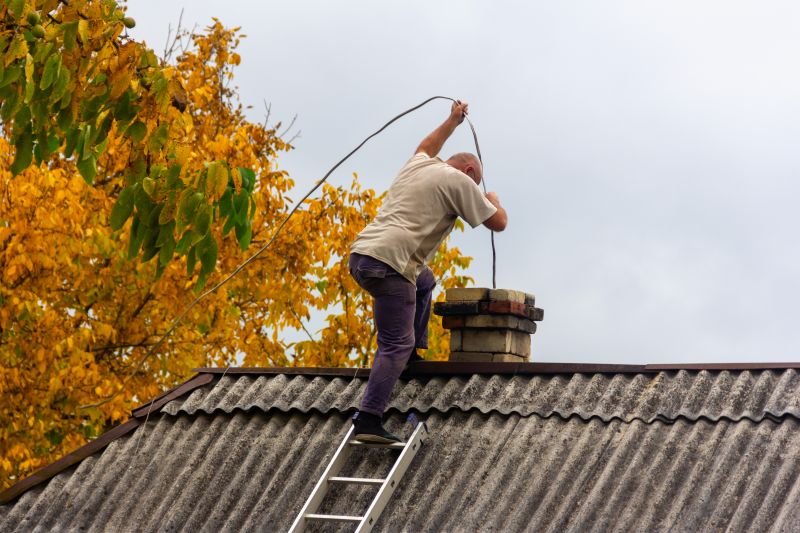Favorite Products For Chimney Removal Projects You Can Count On
Identify trusted tools and accessories that deliver consistent results and make chimney removal safer and faster.
 Removing a chimney can be a complex and potentially hazardous task that requires careful planning and the right tools. Whether you're undertaking a renovation project, addressing structural concerns, or simply removing an outdated chimney, selecting appropriate products is essential for safety and efficiency. The process often involves dismantling the chimney structure, sealing off the flue, and ensuring the surrounding area remains secure and stable. Proper equipment can help streamline these tasks, reducing the risk of damage or injury.
Removing a chimney can be a complex and potentially hazardous task that requires careful planning and the right tools. Whether you're undertaking a renovation project, addressing structural concerns, or simply removing an outdated chimney, selecting appropriate products is essential for safety and efficiency. The process often involves dismantling the chimney structure, sealing off the flue, and ensuring the surrounding area remains secure and stable. Proper equipment can help streamline these tasks, reducing the risk of damage or injury.
Top Overall Option
Heavy-Duty Masonry Demolition Hammer
A versatile demolition hammer designed for breaking down brick and mortar during chimney removal projects. It offers powerful performance with adjustable settings to control impact force, making it suitable for various masonry materials. Its ergonomic design helps reduce user fatigue, and its durability ensures long-term use in demanding tasks.
Types of Products For Chimney Removals
Masonry Saws
Heavy-duty saws designed for cutting through brick, stone, and mortar with precision, facilitating efficient chimney dismantling.
Chimney Crowbars
Robust crowbars ideal for prying apart masonry sections and removing bricks during chimney demolition.
Brick Chisels
Specialized chisels for breaking and shaping bricks, useful for detailed removal work.
Sealants and Patching Compounds
Products designed to seal and patch openings after chimney removal, ensuring structural integrity and safety.
Dust Masks and Respirators
Protective gear essential for safeguarding against dust and debris during demolition.
Protective Gloves and Gear
Safety equipment including gloves, goggles, and coveralls to prevent injuries during removal.
Power Drills with Masonry Bits
Power tools for drilling into masonry surfaces, useful for creating access points or removing sections.
Lifting and Hoisting Equipment
Tools such as pulleys and hoists to assist in lifting heavy chimney sections safely.
Mortar Removal Tools
Specialized tools for efficiently removing mortar joints between bricks.
Structural Support Braces
Supports to stabilize surrounding structures during chimney removal.
Chimney Cap Removal Tools
Tools designed for safely removing chimney caps and crowns.
Vacuum Systems for Dust Control
Industrial vacuums to contain dust and debris during demolition work.
Sealing and Patching Tapes
Flexible tapes for quick sealing of openings post-removal.
Concrete and Masonry Cutters
Tools for cutting through concrete or thick masonry sections.
Chimney Removal Kits
All-in-one kits that include various tools needed for chimney dismantling.
Popular Choices
Widely used for breaking down brick and mortar during chimney removal projects.
Versatile power tool suitable for drilling and chiseling masonry surfaces.
Portable saws designed for cutting through concrete and stone with precision.
Set of heavy-duty crowbars for prying apart masonry and removing bricks.
High-capacity vacuum systems for controlling dust during demolition.
Complete safety gear including gloves, goggles, and masks for demolition safety.
Essential tools for detailed masonry work and brick removal.
Reliable compounds for sealing openings after chimney removal.
Equipment to assist in lifting heavy chimney sections safely.
Tools specialized for removing mortar joints efficiently.
Attachments compatible with power tools for masonry cutting and chiseling.
Supports to reinforce surrounding structures during demolition.
Tools for safely removing chimney caps and crowns.
Chimney removal products are designed to facilitate different aspects of the process, from breaking down masonry to sealing and patching openings. Many tools are engineered to handle heavy-duty materials like brick and mortar, while others focus on sealing and finishing touches to ensure the integrity of the remaining structure. It's important to choose products that match the specific requirements of your project, including the size and type of chimney, as well as the building's construction.
Safety considerations are paramount when removing a chimney. Protective gear, sturdy tools, and reliable sealing products can help prevent accidents and ensure the area remains safe during and after the removal process. Additionally, consulting with professionals or following detailed instructions can help avoid common pitfalls associated with chimney removal projects. Proper planning and the right selection of products can make the task more manageable and less time-consuming.
Ultimately, the goal is to ensure that the removal process is completed thoroughly and safely, with minimal impact on the rest of the structure. Investing in quality products tailored for chimney removal can provide peace of mind and help achieve a clean, secure finish. Whether you're a DIY enthusiast or working with a contractor, understanding your options and choosing the right tools is a crucial step toward successful chimney removal.
Key Buying Considerations
- Assess the size and material of your chimney to choose appropriately rated tools.
- Consider the power and durability of demolition equipment for heavy masonry work.
- Ensure safety gear is sufficient to protect against dust, debris, and sharp objects.
- Evaluate the ease of use and ergonomic design of tools to reduce fatigue.
- Check compatibility of power tools with various attachments for versatility.
- Determine whether specialized tools like mortar removers or sealants are needed for your project.
- Review the weight and portability of equipment for ease of handling during demolition.
- Look for dust control solutions to minimize mess and health hazards.
- Consider the availability of replacement parts and after-sales support.
- Plan for proper disposal or recycling of removed chimney materials.
- Estimate the overall project scope to select tools that match your timeline and budget.
- Verify that tools meet safety standards and have appropriate certifications.
- Think about future projects that may benefit from versatile or multi-purpose tools.
- Assess the need for structural support equipment to maintain building integrity.
- Review user manuals and instructions to ensure proper and safe operation.
